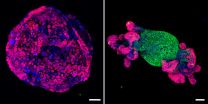Not like riding a bike: New motor memories need stabilizing
2015-06-18
(Press-News.org) Well-practiced motor skills like riding a bike are extremely stable memories that can be effortlessly recalled after years or decades. In contrast, a new study publishing in PLOS Computational Biology shows that changes to motor skill memories occurring over the course of a single practice session are not immediately stable, according to researchers Andrew Brennan and Maurice Smith of Harvard University School of Engineering and Applied Science and Center for Brain Science.
We're all familiar with the old saying that you never forget how to ride a bike and perhaps personally familiar with riding off on a bike years after last putting pedals under your feet. This experience highlights the incredible stability possible for motor skill memories, especially those for well-practiced skills. However, the stability of the new motor memories formed on the shorter timescale of a single practice session has been under debate.
One theory maintains there is a bank of intrinsically stable memories that can be laid down in just a few minutes of practice and that are highly specific to the context surrounding the training. An alternative theory maintains that new motor memories are intrinsically somewhat unstable and tend to be applied over a range of different contexts. Such instability could be beneficial in changing environments, such as maintaining one's running stride while muscles fatigue or donning eyeglasses that will soon be removed, especially if the persistence of the memory tends to match the persistence of environmental changes.
This week's study, designed to rigorously examine this question, found strong evidence that recent changes to motor memories are in fact intrinsically unstable and not strongly context dependent, suggesting each memory is applied in a range of contexts and the motor system would thus require fewer distinct memories.
The instability observed in new motor memories stands in stark contrast to the long-term stability of well-practiced skills like riding a bike. This contrast raises the critical question: how can new motor memories eventually become so stable?
All works published in PLOS Computational Biology are Open Access, which means that all content is immediately and freely available. Use this URL in your coverage to provide readers access to the paper upon publication: http://journals.plos.org/ploscompbiol/article?id=10.1371/journal.pcbi.1004278
INFORMATION:
Press-only preview: https://www.plos.org/wp-content/uploads/2015/06/pcbi.1004278.pdf
Contact:
Maurice Smith
mas@deas.harvard.edu
617-495-9287
Harvard University, School of Engineering and Applied Sciences
Citation: Brennan AE, Smith MA (2015) The Decay of Motor Memories Is Independent of Context Change Detection. PLoS Comput Biol 11(6):e1004278.doi:10.1371/journal.pcbi.1004278
Funding: This work was supported in part by the McKnight Scholar Award, a Sloan Research
Fellowship, and a grant from the National Institute of Aging (R01 AG041878) to MAS and by Natural Sciences and Engineering Research Council of Canada Postgraduate Scholarship-Doctoral to AEB. The funders had no role in study design, data collection and analysis, decision to publish, or preparation of the manuscript.
Competing Interests: The authors have declared that no competing interests exist.
About PLOS Computational Biology
PLOS Computational Biology (http://www.ploscompbiol.org) features works of exceptional significance that further our understanding of living systems at all scales through the application of computational methods. All works published in PLOS Computational Biology are Open Access. All content is immediately available and subject only to the condition that the original authorship and source are properly attributed. Copyright is retained. For more information follow @PLOSCompBiol on Twitter or contact ploscompbiol@plos.org.
About PLOS
PLOS is a nonprofit publisher and advocacy organization founded to accelerate progress in science and medicine by leading a transformation in research communication. For more information, visit http://www.plos.org.
ELSE PRESS RELEASES FROM THIS DATE:
2015-06-18
Chlamydia trachomatis is a formidable foe. It's the most common sexually transmitted pathogen, infecting more than 100 million people each year. In the developing world, chlamydial infection is the leading cause of preventable blindness. Around the world, it ranks as the number one cause of infertility and ectopic pregnancy.
Chlamydial infection ignites chronic inflammation, which scars mucosal surfaces such as eyelids, ovaries or fallopian tubes. Most people who carry the bacterium don't know it. Women with chlamydia are much more vulnerable to other sexually transmitted ...
2015-06-18
To predict how a seasonal influenza epidemic will spread across the United States, one should focus more on the mobility of people than on their geographic proximity, a new study suggests.
PLOS Pathogens published the analysis of transportation data and flu cases conducted by Emory University biologists. Their results mark the first time genetic patterns for the spread of flu have been detected at the scale of the continental United States.
"We found that the spread of a flu epidemic is somewhat predictable by looking at transportation data, especially ground commuter ...
2015-06-18
Baboons live in a strongly hierarchical society, but the big guys don't make all the decisions.
A new study from the University of California, Davis, reveals -- through GPS tracking -- that animals living in complex, stratified societies make some decisions democratically. The study breaks ground in how animal behavior data is collected.
The study is being published Friday (June 19) in Science.
"It's not necessarily the biggest alpha males that influence where groups go," said co-author Meg Crofoot, assistant professor of anthropology at UC Davis. "Our results illustrate ...
2015-06-18
DNA from the 8,500-year-old skeleton of an adult man found in 1996, in Washington, is more closely related to Native American populations than to any other population in the world, according to an international collaborative study conducted by scientists at the University of Copenhagen and the Stanford University School of Medicine.
The finding challenges a 2014 study that concluded, based on anatomical data, that Kennewick Man was more related to indigenous Japanese or Polynesian peoples than to Native Americans. The study is likely to reignite a long-standing legal ...
2015-06-18
NASA provided four different views of Tropical Depression Bill as it continued traveling through the south-central U.S. and into the Ohio Valley. NASA's Aqua and Terra satellite provided infrared and visible imagery while NASA/NOAA's GOES Project animated NOAA's GOES-East satellite imagery to show the storm's progression since landfall. The Global Precipitation Measurement or GPM core satellite also showed rainfall estimates and locations.
On June 18, the National Weather Service, Weather Prediction Center (NWS/WPC) noted that flood and flash flood watches and warnings ...
2015-06-18
Kangaroos prefer to use one of their hands over the other for everyday tasks in much the same way that humans do, with one notable difference: generally speaking, kangaroos are lefties. The finding, reported in the Cell Press journal Current Biology on June 18--the first to consider handedness in wild kangaroos--challenges the notion that "true" handedness among mammals is a feature unique to primates.
"According to a special-assessment scale of handedness adopted for primates, kangaroos pulled down the highest grades," says Yegor Malashichev of Saint Petersburg State ...
2015-06-18
Anti-cancer strategies generally involve killing off tumor cells. However, cancer cells may instead be coaxed to turn back into normal tissue simply by reactivating a single gene, according to a study published June 18th in the journal Cell. Researchers found that restoring normal levels of a human colorectal cancer gene in mice stopped tumor growth and re-established normal intestinal function within only 4 days. Remarkably, tumors were eliminated within 2 weeks, and signs of cancer were prevented months later. The findings provide proof of principle that restoring the ...
2015-06-18
American scientists have discovered that a drug commonly used to treat osteoporosis in humans also stimulates the production of cells that control insulin balance in diabetic mice. While other compounds have been shown to have this effect, the drug (Denosumab) is already FDA approved and could more quickly move to clinical trials as a diabetes treatment. The research is published June 18 in Cell Metabolism.
Diabetes is a major health issue worldwide that arises due to a deficiency of insulin-producing beta cells in the pancreas. In type 1 diabetes, beta cells die from ...
2015-06-18
Cutaneous melanoma, the most deadly form of skin cancer, is now believed to be divided into four distinct genomic subtypes, say researchers at The University of Texas MD Anderson Cancer Center, a finding that could prove valuable in the ever-increasing pursuit of personalized medicine.
As part of The Cancer Genome Atlas, researchers identified four melanoma subtypes: BRAF, RAS, NF1 and Triple-WT, which were defined by presence or absence of mutations from analysis of samples obtained from 331 patients. The five-year study resulted from an international collaboration of ...
2015-06-18
PHILADELPHIA -- Most of us need seven to eight hours of sleep a night to function well, but some people seem to need a lot less sleep. The difference is largely due to genetic variability. In research published online June 18th in Current Biology, researchers report that two genes, originally known for their regulation of cell division, are required for normal slumber in fly models of sleep: taranis and Cyclin-dependent kinase 1 (Cdk1).
'There's a lot we don't understand about sleep, especially when it comes to the protein machinery that initiates the process on the ...
LAST 30 PRESS RELEASES:
[Press-News.org] Not like riding a bike: New motor memories need stabilizing


